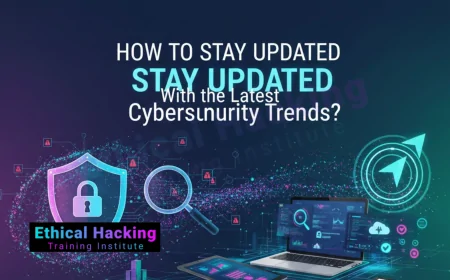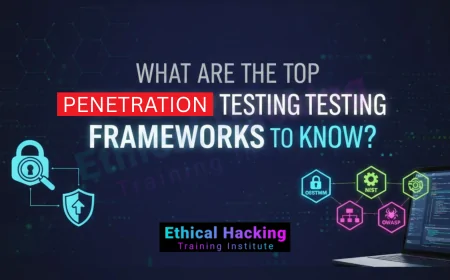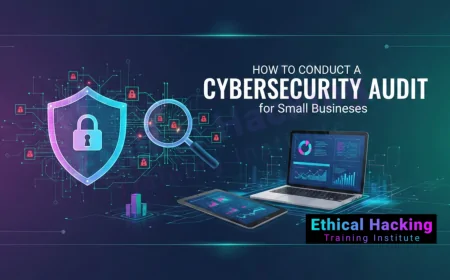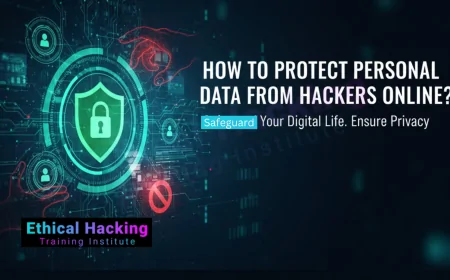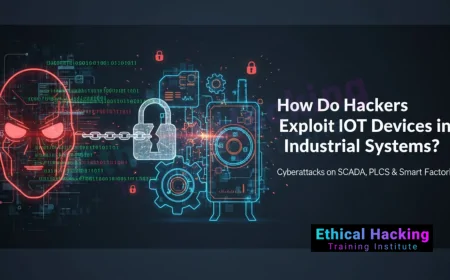Master Nmap Hacking for Ethical Hacking and Penetration Testing | Learn Nmap for Ethical Hacking: A Complete Guide to Network Scanning
Master Nmap for ethical hacking and penetration testing. Learn powerful Nmap commands, scan types, OS detection, scripting, and real-world techniques. Perfect for CEH, OSCP, and cybersecurity professionals in 2025.
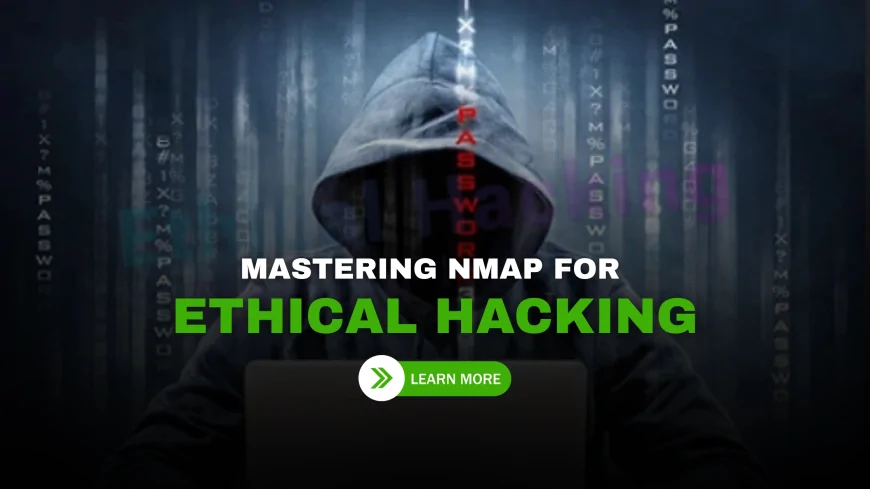
Table of Contents (HTML Format) html Copy Edit
- Introduction
- What is Nmap?
- Why Ethical Hackers Use Nmap
- Types of Nmap Scans Explained
- Top Nmap Commands for Penetration Testing
- Nmap Scripting Engine (NSE)
- Operating System Detection with Nmap
- Service & Version Detection
- Bypassing Firewalls with Nmap
- Visualizing and Exporting Nmap Reports
- Advanced Nmap Techniques
- Real-World Use Cases of Nmap
- Nmap vs Other Network Scanners
- Legal Considerations for Using Nmap
- Nmap in CEH and OSCP Training
- Best Tools to Combine with Nmap
- Best Resources to Learn Nmap
- Career Benefits of Mastering Nmap
- FAQs
- Conclusion
Introduction
In the world of cybersecurity, Nmap (Network Mapper) is one of the most powerful tools for reconnaissance. Whether you're a penetration tester, ethical hacker, or red team member, mastering Nmap is non-negotiable. This comprehensive guide explores everything you need to know about Nmap—from basic scans to advanced techniques—to enhance your ethical hacking arsenal.
What is Nmap?
Nmap is a free and open-source tool used for:
-
Network discovery
-
Port scanning
-
Service enumeration
-
Vulnerability detection
Developed by Gordon Lyon (Fyodor), Nmap has become the industry standard in network mapping and footprinting.
Why Ethical Hackers Use Nmap
Ethical hackers use Nmap because it helps:
-
Identify live hosts on a network
-
Discover open ports and services
-
Reveal OS and software versions
-
Detect potential vulnerabilities
-
Map network topology
Nmap is often the first tool used in the hacking lifecycle during the Reconnaissance and Scanning phase.
Types of Nmap Scans Explained
| Scan Type | Description |
|---|---|
| SYN Scan (-sS) | Fast & stealthy scan (half-open TCP) |
| TCP Connect (-sT) | Completes full TCP connection |
| UDP Scan (-sU) | Scans for UDP ports |
| ACK Scan (-sA) | Firewall detection |
| Xmas Scan (-sX) | Sends FIN, URG, and PUSH flags |
| Null Scan (-sN) | Sends packet with no flags |
| FIN Scan (-sF) | Sends FIN packet to detect open ports |
| Ping Scan (-sn) | Checks if hosts are online |
| Version Detection (-sV) | Detects software version running on ports |
| OS Detection (-O) | Tries to detect the operating system |
Top Nmap Commands for Penetration Testing
Nmap is a versatile scanner and one of the most essential tools in a penetration tester’s toolkit. It helps identify vulnerabilities, understand the network layout, and locate open ports/services. Below are some of the most effective Nmap commands used in real-world ethical hacking engagements:
1. Basic SYN Scan (Stealthy and Fast): Performs a stealth scan (half-open TCP), often bypassing firewalls and IDS systems.
2. Full TCP Port Scan: Scans all 65,535 TCP ports to find every open service.
3. Service Version Detection: Identifies the software and version running on detected ports.
4. Aggressive Scan (OS, Services, Scripts, Traceroute): Performs OS detection, version detection, script scanning, and traceroute in a single command.
5. Operating System Detection: Tries to detect the target machine's operating system using TCP/IP stack fingerprinting.
6. UDP Scan: Scans for open UDP ports like DNS (53) and SNMP (161).
7. Vulnerability Scan Using NSE Scripts: Runs vulnerability detection scripts to find common exploits.
8. Host Discovery Without Port Scan: Identifies which hosts are alive in a subnet (useful for mapping networks).
9. Scan Top 1000 Ports with Verbose Output: Default scan of top 1000 ports with real-time output details.
10. Save Scan Results to a File:Saves scan results in a normal, readable format.
Top Nmap Commands for Penetration Testing
In penetration testing, Nmap serves as an essential reconnaissance tool that reveals valuable network intelligence. The key to leveraging Nmap effectively is mastering its most practical commands. These commands allow ethical hackers to scan for open ports, identify running services, detect operating systems, and even uncover potential vulnerabilities.
1. Stealth SYN Scan (Quick & Silent)
2. Full Port Scan with Service Version Detection
3. Aggressive Scan (All-in-One)
4. UDP Port Scan
5. Script-Based Vulnerability Scan
6. Ping Sweep (Host Discovery)
Nmap Scripting Engine (NSE)
The Nmap Scripting Engine allows custom scripts for:
-
Vulnerability detection (
vuln) -
Brute-force login attempts (
brute) -
Malware detection
-
Firewall evasion
-
Web scanning
Example:
Operating System Detection with Nmap
Use -O for detecting OS:
Nmap analyzes TCP/IP stack behavior to guess the OS, including Windows, Linux, Unix, and embedded systems.
Service & Version Detection
Use the -sV option to identify services:
Nmap will try to identify version banners like:
-
Apache/2.4.49
-
OpenSSH 7.4p1
-
MySQL 5.7.33
Bypassing Firewalls with Nmap
Firewall evasion techniques:
-
Use decoy scans:
--decoy -
Fragment packets:
-f -
Spoof source IP:
-S -
Randomize targets:
--randomize-hosts
These help evade IDS/IPS detection in controlled pentest environments.
Visualizing and Exporting Nmap Reports
Output formats:
-
Normal:
-oN -
XML:
-oX -
Grepable:
-oG -
JSON: via
Nmap JSON Output NSE script
Visualization Tools:
-
Zenmap (official GUI)
-
Nmap Parser
-
NDiff (for comparing scans)
Advanced Nmap Techniques
-
Timing templates:
-T0(slowest) to-T5(fastest) -
Scan large networks efficiently with
--min-hostgroup -
Use IPv6 scanning:
nmap -6 -
Combine with Masscan for speed
Real-World Use Cases of Nmap
-
Vulnerability assessments
-
Network auditing
-
Firewall rule testing
-
Compliance scanning
-
Attack surface mapping
-
Red teaming reconnaissance
Nmap vs Other Network Scanners
| Tool | Strength | Limitation |
|---|---|---|
| Nmap | Versatile, scriptable | Slower on huge networks |
| Masscan | Very fast | No service detection |
| Zmap | High-speed scanning | Basic scan details |
| Angry IP Scanner | Simple GUI | Lacks deep scan features |
Legal Considerations for Using Nmap
Only scan networks you:
-
Own
-
Have written permission to scan
Unauthorized use of Nmap is illegal in many countries under Cybercrime Acts and can result in prosecution.
Nmap in CEH and OSCP Training
Nmap is part of:
-
CEH (Certified Ethical Hacker) Module 2: Scanning
-
OSCP Exam and labs
-
CompTIA PenTest+
-
eJPT and eCPTX exams
Mastering Nmap helps you succeed in multiple cybersecurity certifications.
Best Tools to Combine with Nmap
-
Metasploit Framework
-
Nikto
-
Netcat
-
Wireshark
-
Masscan
-
Gobuster
-
Burp Suite
-
Shodan
These tools complement Nmap for a complete penetration test workflow.
Best Resources to Learn Nmap
-
Nmap.org Official Documentation
-
Nmap Network Scanning (Fyodor’s Book)
-
TryHackMe: Nmap Room
-
Hack The Box Labs
-
YouTube channels (The Cyber Mentor, NetworkChuck)
-
Reddit: r/HowToHack, r/netsecstudents
Career Benefits of Mastering Nmap
-
Boosts your resume for pentesting roles
-
Demonstrates hands-on network knowledge
-
Prepares you for real-world cybersecurity assessments
-
Adds practical value to CEH, OSCP, and SOC analyst roles
FAQs
1. What is Nmap used for?
Nmap is a network scanning tool used to discover hosts, open ports, services, and vulnerabilities on a network.
2. Is Nmap free?
Yes, Nmap is completely free and open source.
3. Is Nmap legal to use?
Yes, but only on networks you own or have explicit permission to scan.
4. What OS is Nmap compatible with?
Nmap works on Windows, Linux, macOS, and FreeBSD.
5. What is a SYN scan?
A SYN scan is a fast, stealthy scan that sends half-open TCP connections to identify open ports.
6. What does the -sV option do?
It enables version detection to find software and versions running on open ports.
7. What is the difference between -sT and -sS scans?
-sT performs full TCP connections; -sS uses half-open SYN scans (stealthier).
8. Can Nmap detect firewalls?
Yes, using ACK scans and other firewall-evading techniques.
9. What is Nmap Scripting Engine (NSE)?
NSE allows users to write and execute custom scripts for advanced scanning tasks.
10. Can Nmap scan UDP ports?
Yes, using the -sU option, though it’s slower and less reliable than TCP scans.
11. Is Nmap included in Kali Linux?
Yes, it comes pre-installed in Kali Linux and other security-focused distros.
12. How do I scan a whole subnet with Nmap?
Use CIDR notation: nmap 192.168.1.0/24
13. What’s the best Nmap command for beginners?
nmap -sS -v 192.168.1.1 is a good starting point for learning.
14. Can Nmap detect operating systems?
Yes, with the -O option, though accuracy may vary.
15. How do I install Nmap?
Use your system’s package manager: apt install nmap (Linux), download from nmap.org for Windows/macOS.
16. What are some GUI tools for Nmap?
Zenmap is the official GUI for Nmap.
17. Can Nmap find vulnerabilities?
Yes, especially when using NSE scripts like --script vuln.
18. What is decoy scanning in Nmap?
A technique where multiple fake IPs are used to hide the source of the scan.
19. What is the fastest way to scan a network?
Use -T5 aggressive timing and limit ports with -p.
20. Where can I practice Nmap legally?
Use platforms like TryHackMe, Hack The Box, or set up a local lab with VMs.
Conclusion
Mastering Nmap is a foundational skill every ethical hacker must possess. It allows you to see the digital terrain before you strike—a true recon master’s tool. From discovering open ports to automating vulnerability detection with scripts, Nmap helps identify weaknesses and take control of your assessment. Whether preparing for CEH or working in the field, your cybersecurity journey should begin with Nmap.
What's Your Reaction?
 Like
0
Like
0
 Dislike
0
Dislike
0
 Love
0
Love
0
 Funny
0
Funny
0
 Angry
0
Angry
0
 Sad
0
Sad
0
 Wow
0
Wow
0

